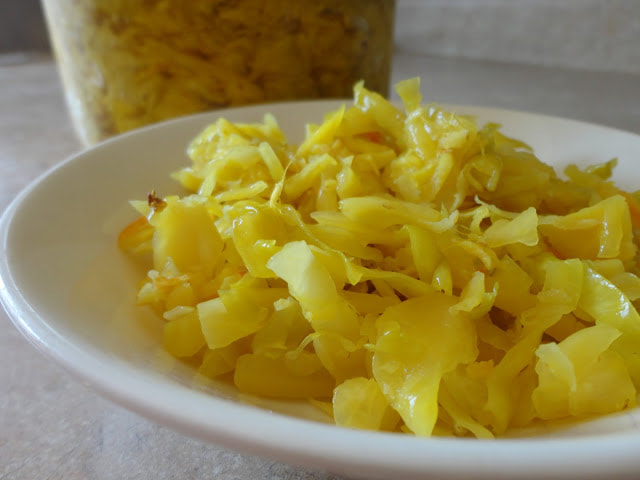|
This is my new favorite sauerkraut recipe, because it is super flavorful and a beautiful golden color. It reminds me of sunshine, hence the name "sunnyside" kraut, which is perfect now that the sun is starting to come back. This is made with anti-inflammatory foods like ginger and turmeric, which also promote digestion. The beets are great for the liver and help with the methylation process in the body due to their betaine content. Foods like sauerkraut that are acidic and made with unrefined salt are important in helping your body to make proper stomach acid. This kraut is a great digestive promoter and immune supporter because of the probiotic content, which goes a long way in supporting a healthy microbiome. A little tart and sweet, it goes well with almost any food. I love mine on over-easy eggs at breakfast, but it is also great with sausages, fish, or on a salad. Sunnyside Sauerkraut
Makes 2 quarts 1 large head green or napa cabbage (about 3 pounds), shredded 2 large golden beets, grated (about 1 lb) 2" ginger root, grated 2" fresh turmeric root, grated (if you can't find fresh, use 1 tsp powdered) Zest and juice of 1 lemon 2-3 Tbs sea salt, or to taste In a large bowl, combine the cabbage, beets, ginger, turmeric, lemon and sea salt. Massage the salt into the veggies to soften them and begin to release their water. Taste for saltiness, and add if you like it a little saltier. Pack into glass jars or a fermenting crock, filling the container and packing it down with a wooden spoon. This removes air bubbles and lets you fit more cabbage in, as well as helping to push up the brine to cover the vegetables. Continue to fill and pack the container until all the veggie mixture is gone, or until the container is completely full, leaving an inch or so of room for brine. Press down with your hand until the brine covers the vegetables by about 1 inch. You can use a fermenting weight, such as "Pickle Pebbles" at this point if you want to ensure the brine stays above the kraut. Cover with a lid on your jar or cloth if using a crock. If using a jar with a lid, do not screw on too tightly. Unscrew and then return the lid every day or two to "burp" the kraut, as pressure from CO2 can build up from the bacteria and could cause the jar to break. This also lets you check the surface regularly for mold and to ensure the kraut stays below the brine. Let sit about 2 weeks, depending on the temperature of your kitchen and taste preference. Refrigerate after it is fermented to your liking. This should keep at least 1 year in cold storage.
1 Comment
Tony
1/2/2023 08:15:27 am
In your sauerkraut recipe, you indicate, “Press down with your hand until the brine covers the vegetables…”
Reply
Leave a Reply. |
Brine & Broth
I am a gut health-focused nutritionist and online health coach based in Southwest Wisconsin. My recipes and philosophies center around traditional, nutrient-dense foods that support robust gut health. Archives
May 2022
Categories |


 RSS Feed
RSS Feed
